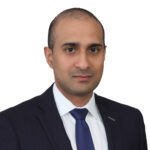Financial firms have the power to encourage companies to take on more ambitious steps to lower their carbon footprints
With just 27 years to go until 2050 – the deadline for countries and businesses to reach net-zero carbon emissions – there’s enormous pressure on companies to reduce their climate-related risks. Moving to net-zero isn’t going to be easy – it requires a lot of capital and the will to make change. Asset managers, however, are uniquely positioned to help businesses achieve their net-zero goals.
Increasingly, managers believe that the companies trying to lower their environmental risk will be better positioned for the future, which is not only good for the planet, but also for investment returns. Yet businesses are strapped for resources and often lack the expertise to deal with this challenge, which is why some financial companies are now trying to help businesses meet their targets by offering climate solutions that bridge policy, science and finance.
While there are still skeptics about the impact climate will have on the broader economy, many business leaders acknowledge the significant risk. According to the inaugural BMO Climate Institute survey of small- and medium-sized businesses in North America, 69 per cent of respondents expect the physical impacts of climate will disrupt operations over the next five years. Another third say severe weather patterns are already creating challenges.
Managing climate risk
When it comes to climate risk, we believe asset managers need to consider environmental challenges. Fixed-income managers in particular can’t afford to ignore environmental, social and governance (ESG) factors when assessing credit risk, says Vishang Chawla, Portfolio Manager, Active Fixed Income at BMO Global Asset Management.
“When you look at ESG, you have to think about which companies are going to be around 10, 20 and 30 years from now because we’re buying 30-year bonds,” notes Chawla. “As a credit analyst, when you make that investment, you have to ask yourself if you want to own this company for 30 years. So you have to think about net-zero.”
Fixed-income asset managers are doing more than deciding which investments to hold – they’re engaging company leadership to adopt net-zero. Unlike with equities, the money raised by sustainable bonds should be earmarked for specific projects, explains Chawla. As a result, asset managers can analyze a net-zero plan and assess whether it’s going to advance the company’s net-zero goals. This gives asset managers the opportunity to provide guidance to management on how to strengthen their ESG initiatives if it finds their plans are lacking, he adds.
“As active managers of billions of dollars of credit, part of our responsibility is being in touch with the management of those companies, asking the tough questions and looking at the balance sheet,” says Earl Davis, Head of Fixed Income and Money Markets at BMO Global Asset Management. “It’s from there that you start seeing trends and are able to push or influence companies.”
The interactions between asset managers and companies can be notable. When a large Canadian energy company was raising funds for its sustainability initiatives, BMO Global Asset Management engaged with this company to encourage it to adopt stronger net-zero goals.
Making a measurable impact
The Global Impact Investing Network estimates the market for impact funds, which includes sustainable funds, to be about US$1.16 trillion dollars. Sustainable funds seek to invest in companies that are attractive from both a financial return and ESG perspective. The issuance of green bonds, which are financial instruments designed to fund projects that have environmental or climate benefits, have been an important contributor to that growth.
Sustainable bond funds offer an effective way to tap into the green bond market. With these funds, you’re getting access to companies that have used green bonds to affect change for specific projects. They include projects like Brookfield Asset Management’s push to extend the life and increase the capacity at Shepherds Flat, one of the largest onshore wind projects in the U.S. By replacing the existing turbines with longer blades and updated technology the company expects the project will increase its generation capacity of clean energy by about 25 percent per year, or about 400-gigawatt hours. Bell Canada is another example. The telecom recently issued a sustainable linked bond to fund a variety of renewable energy projects to offset its carbon footprint as it upgrades its 5G network.
Taking a long-term view
Asset managers must take a long-term view of the impact of climate change, but the industry is facing pressure to put short-term returns first. Some managers are concerned that the push to net-zero contradicts the goal of providing the best risk-adjusted return. At least one large asset manager has caved to these pressures by pulling out of an investment-industry initiative on climate change, claiming that having a stance on net-zero conflicts with its ability to remain independent.
Davis thinks the pushback against net-zero is short-sighted. “When we invest, we invest from a net present value perspective, so from that you look at the cash flows going through in the future,” he says. This perspective doesn’t mean you have to sacrifice returns, he adds, noting that the risk profiles and performance of many sustainable bond funds are similar to conventional bond funds.
The difference comes down to how managers weigh risk. The risks fixed income managers are looking for may not be making headlines today, but if those risks increase in the future, then it could have a material impact on a company’s performance. “Part of our role is to ensure future sustainable financial returns,” he says.
For BMO Global Asset Management’s Davis, it’s about working with the companies to find solutions that make sense and will deliver results. “When you think about net-zero as a whole, no one person or institution could do it on their own,” he says. “This has to be a global effort.”
Contributor Disclaimer
The viewpoints expressed by the individual portfolio manager represent their assessment of the markets at the time of publication. Those views are subject to change without notice at any time without any kind of notice. The information provided herein does not constitute a solicitation of an offer to buy, or an offer to sell securities nor should the information be relied upon as investment advice. Past performance is no guarantee of future results. This communication is intended for informational purposes only.
BMO Global Asset Management is a brand name under which BMO Asset Management Inc. and BMO Investments Inc. operate.
®/™Registered trademarks/trademark of Bank of Montreal, used under licence.
RIA Disclaimer
The views and opinions expressed in this article are solely those of the authors and do not necessarily reflect the view or position of the Responsible Investment Association (RIA). The RIA does not endorse, recommend, or guarantee any of the claims made by the authors. This article is intended as general information and not investment advice. We recommend consulting with a qualified advisor or investment professional prior to making any investment or investment-related decision.


